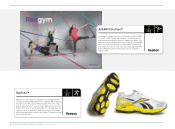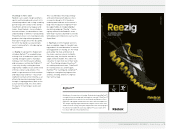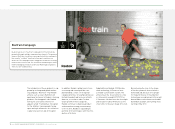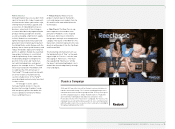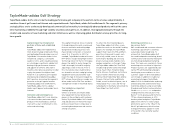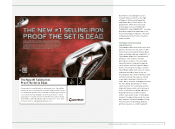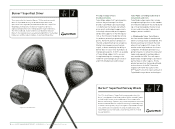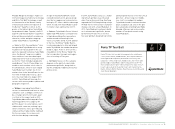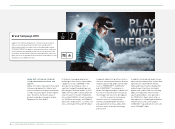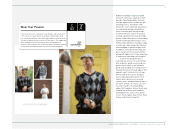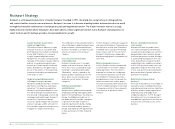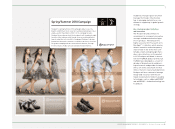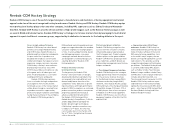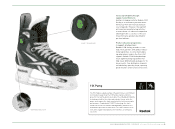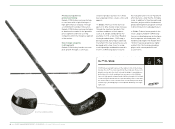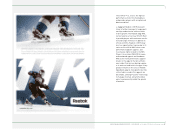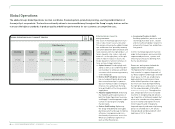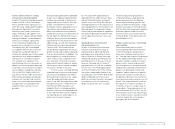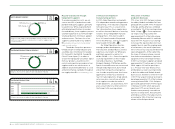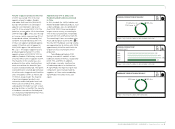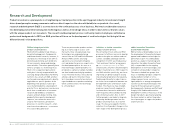Reebok 2009 Annual Report Download - page 86
Download and view the complete annual report
Please find page 86 of the 2009 Reebok annual report below. You can navigate through the pages in the report by either clicking on the pages listed below, or by using the keyword search tool below to find specific information within the annual report.
82 GROUP MANAGEMENT REPORT – OUR GROUP Rockport Strategy
Rockport Strategy
Rockport is a US-based manufacturer of leather footwear. Founded in 1971, the brand has a long history of selling walking
and comfort leather shoes for men and women. Rockport’s mission is to become a leading leather footwear brand in the world
through the innovative combination of contemporary style and engineered comfort. The leather footwear market is a large,
highly attractive market where few players have been able to achieve significant market share. Rockport’s brand position in
select markets and its heritage provide a strong foundation for growth.
Leather footwear market offers
significant opportunity
The leather footwear industry is highly
attractive in terms of size, growth and
profit potential. The market is estimated
at over US$ 70 billion. It is currently
a highly fragmented global market.
Rockport has one of the strongest brand
heritages in the leather footwear industry
and has strong brand recognition, par-
ticularly in its home market, the United
States. Rockport has the opportunity to
be one of the winners in this industry by
achieving sustainable, profitable growth
in the years to come.
Global brand positioning relevant
to Rockport’s target consumer
Rockport’s brand positioning is “Comfort-
ably stylish, contemporary, and always
innovative”. This positioning builds on
Rockport’s existing brand equity in com-
fort and technological innovation while
also focusing on developing a stylish and
contemporary brand through Rockport’s
world-class, international design
resources, broad category and consumer
end use coverage, and the utilisation of
three product range fashion expressions
to appeal to a large consumer base.
The combination of these brand elements
attracts Rockport’s globally relevant main
target consumer, the metropolitan pro-
fessional. The brand is currently focused
almost exclusively on the footwear
category.
Focus on consistent execution
of brand direction
Rockport’s brand vision is to enable
people to do more, be more, and live
more. This vision is achieved through
the brand’s shoemaking philosophy,
“Walkability”, which is applied to the
brand’s products spanning across the
dress, dress casual, relaxed casual
and active casual leather footwear
categories.
Globalise brand, product
and distribution
Rockport has a globally relevant brand
and product offering with regional distri-
bution in the United States, the Americas,
Europe, the Middle East and Asia. Its
key global priorities include: strengthen
its position in the USA, establish a
regional organisation to build a founda-
tion for the brand and drive growth in
Europe, and exploit growth opportunities
in Asia, particularly in China, India and
Korea.
In 2009, Rockport continued to expand its
international distribution. The brand now
does business in more than 55 markets
worldwide. Sales outside of the United
States now account for close to half of
Rockport’s total business and double-
digit percentage growth is planned in the
near term.
Build a dual gender business
In 2009, Rockport further strengthened
its investments in its women’s product
and design teams. This investment is
expected to translate into solid growth
in the women’s business in 2010, with
the introduction of balanced, holistic,
branded women’s lines that provide the
female consumer with a value propos-
ition that incorporates both fashion and
comfort, thereby freeing her of the need
to compromise either of these elements
in her decision to purchase leather
footwear.
Roll out a profitable mono-brand
retail concept
Rockport will drive the global rollout
of its newly created mono-brand retail
concept, whose prototypes are currently
being piloted in select markets. Based
on encouraging results to date, Rockport
is accelerating the expansion of its new
mono-brand retail concept in the USA
and piloting stores in additional markets
in 2010. Full-price own-retail stores are
expected to comprise more than a fifth
of total sales by 2014 and are planned to
be the main driver of growth within the
brand over that period.
Build effective organisational
processes
2009 saw increased focus on a number of
operational areas including forecasting
and order processing accuracy, lead-time
reduction, product range segmentation
and productivity and supply chain
complexity reduction. In 2010, Rockport
will continue its focus to improve these
and additional operational areas that are
critical to the continued success of the
business.


